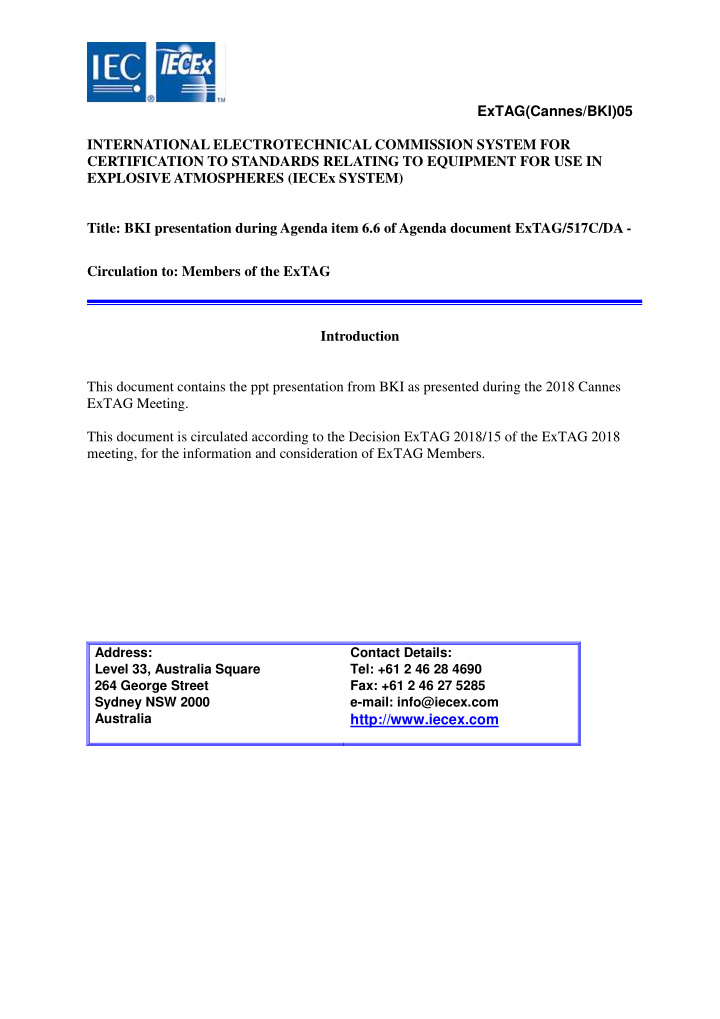



ExTAG(Cannes/BKI)05 INTERNATIONAL ELECTROTECHNICAL COMMISSION SYSTEM FOR CERTIFICATION TO STANDARDS RELATING TO EQUIPMENT FOR USE IN EXPLOSIVE ATMOSPHERES (IECEx SYSTEM) Title: BKI presentation during Agenda item 6.6 of Agenda document ExTAG/517C/DA - Circulation to: Members of the ExTAG Introduction This document contains the ppt presentation from BKI as presented during the 2018 Cannes ExTAG Meeting. This document is circulated according to the Decision ExTAG 2018/15 of the ExTAG 2018 meeting, for the information and consideration of ExTAG Members. Address: Contact Details: Level 33, Australia Square Tel: +61 2 46 28 4690 264 George Street Fax: +61 2 46 27 5285 Sydney NSW 2000 e-mail: info@iecex.com Australia http://www.iecex.com
Batter ery S Surface T ce Temperature e Asses essment for Equipment Protection Level ‘ib’ According to 60079-11; 10.5.3; b)
Exception for ‘ib’ – part 1 10.5.3 Spark ignition and surface temperature of cells and batteries […] b) Cells shall be tested […] For ‘ia’ and ‘ib’ all current-limiting devices external to the cell or battery shall be short-circuited for the test. The test shall be carried out both with internal current-limiting devices in circuit and with the devices short-circuited using 10 cells in each case. The 10 samples having the internal current-limiting devices short-circuited shall be obtained from the cell/battery manufacturer together with any special instructions or precautions necessary for safe use and testing of the samples. If the internal current limiting devices protect against internal shorts then these devices need not be removed. However, such devices shall only be considered for Level of Protection ‘ib’.
Exception for ‘ib’ – part 2 If the internal current limiting devices protect against internal shorts then these devices need not be removed. Internal to the battery or internal to the cell? Definitions in 60079-0: • 3.5.1 battery: assembly of two or more cells electrically connected to each other to increase the voltage or capacity. • 3.5.3 cell: assembly of electrodes and electrolyte which constitutes the smallest electrical unit of a battery.
Interpretation 1: “internal to the cell” • If a current limiting device is internal to the cell, it need not be removed for testing in case of ‘ib’, however in case of ‘ia’ all current limiting devices need to be removed for testing. This creates contradictions: • If the current limiting device is a functional part of the cell (e.g. melting separator), then testing for the case of ‘ia’ would be impossible, as the removal of this part would make the cell inoperable/untestable. • If the current limiting device is an additional part to the cell (e.g. internal fuse), then circuit-wise it would be the same as a fuse on the external protective PCB, thus this would not be considered internal to the cell, as the cell “constitutes the smallest electrical unit” of the battery.
Interpretation 2: “internal to the battery” • Current limiting devices are added to the protective circuit board which must comply with requirements of protection level ‘ib’. These devices are internal to the battery and with the ‘ib’ protection level they protect against internal shorts on the protective PCB. For this reason they need not be removed for assessment of ‘ib’ equipment. However these would still need to be removed for assessment of ‘ia’ equipment. • This interpretation does not create contradiction.
Interpretation 2 is also supported by Annex E in 60079-1 (flameproof enclosures d): E.4.1 Prevention of excessive temperature and cell damage E.4.1.1 Under short-circuit discharge conditions, batteries shall either meet both conditions below, or be fitted with a safety device, as described in E.4.1.2: a) the external surface temperature of the cell or battery shall not exceed the continuous operating temperature specified by the cell or battery manufacturer taking into account the local ambient temperature within the enclosure; and b) the maximum discharge current shall not exceed that specified by the cell or battery manufacturer. E.4.1.2 Where the two conditions in E.4.1.1 above cannot be achieved, a safety device is required which shall comply with the requirements for infallible components in level of protection “ib” as defined in IEC 60079-11, and be located as close to the cell or battery terminals as is reasonably practicable, and be either: • a resistor or current-limiting device, which limits the current to the maximum continuous withdrawal current specified by the battery manufacturer; or • a fuse conforming with the IEC 60127 series, selected so that the fusing characteristic prevents the maximum withdrawal current and allowable duration specified by the battery manufacturer from being exceeded. Where the fuse is of the replaceable type, a label shall be provided adjacent to the fuse holder, specifying the type of fuse to be used. The rating of the resistor or current-limiting device shall be based on the voltage of the cell or battery.
Interpretation 2 was applied by BKI: ib Short circuit on battery terminals The battery is screw mounted into the device.
Recommend
More recommend